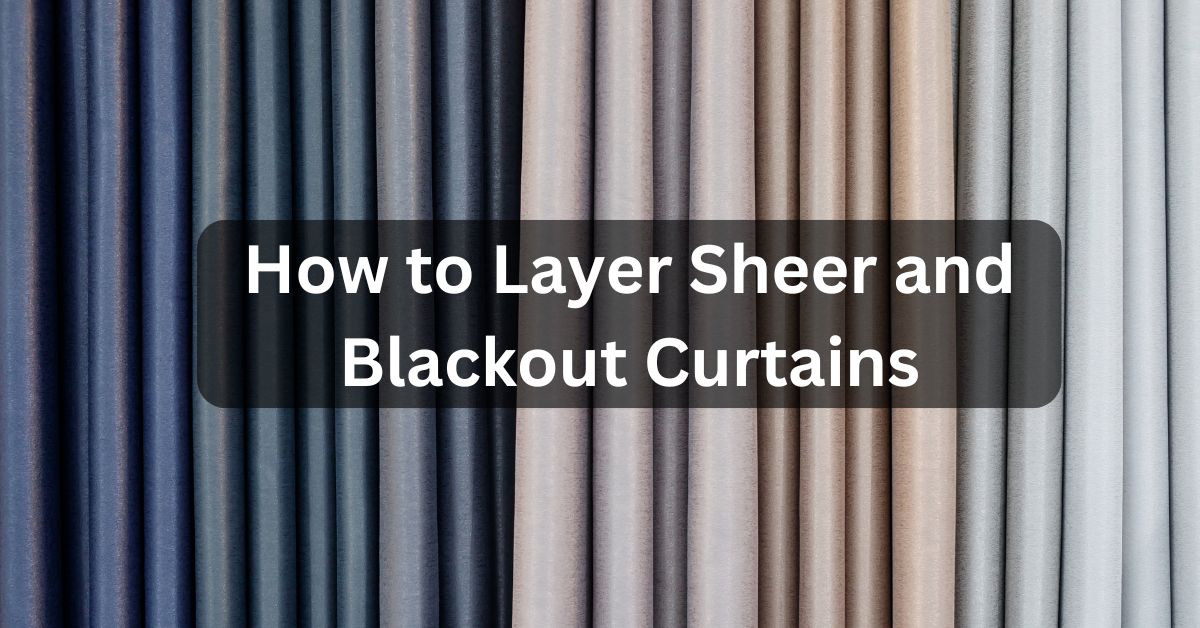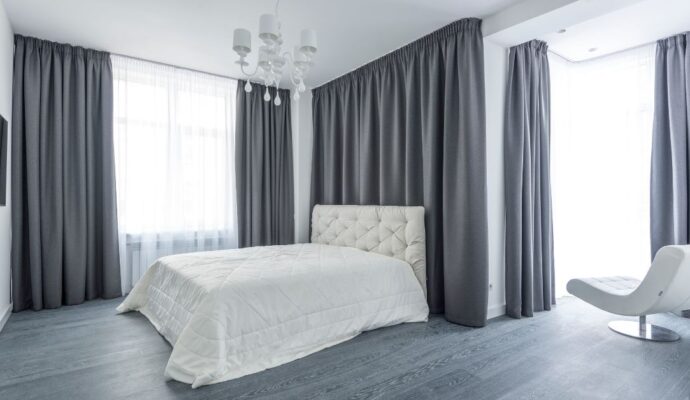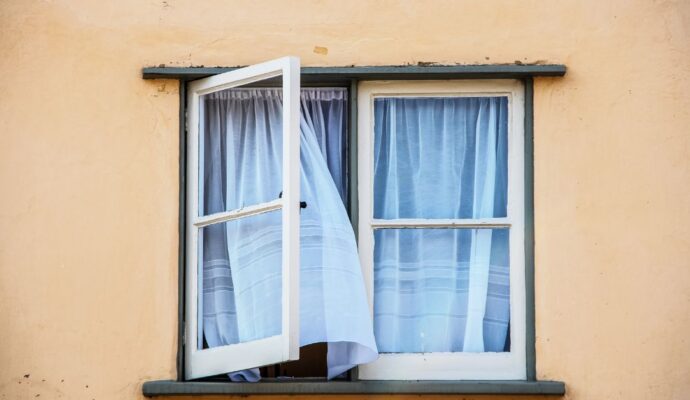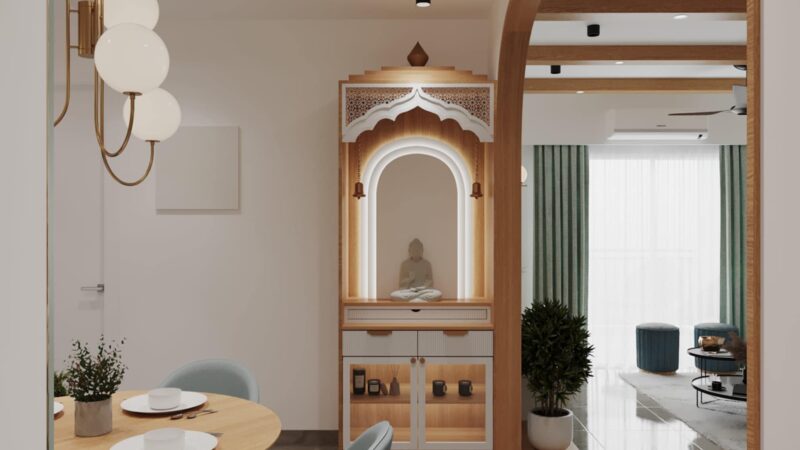Mastering the Art of Layering: How to Layer Sheer and Blackout Curtains for Maximum Style and Functionality

Curtains are not just functional elements in a room, they are essential components of interior design that can enhance the ambiance, style, and functionality of any space. Among the various curtain styles available, sheer and blackout curtains stand out for their unique characteristics and versatile applications. But what if you could combine the best of both worlds? That’s where the art of layering sheer and blackout curtains comes into play.
In this comprehensive guide, we will delve into the fascinating world of layered curtains, exploring how this technique can transform your living spaces. From achieving the perfect balance between natural light and privacy to infusing your rooms with style and sophistication, mastering the art of layering curtains opens up a realm of possibilities for homeowners and interior enthusiasts alike.

So, whether you’re looking to refresh your home decor or simply seeking inspiration to elevate your window treatments, join us on this journey as we uncover the secrets of layering sheer and blackout curtains for maximum impact and aesthetic appeal.
Understanding Sheer and Blackout Curtains
Sheer curtains are renowned for their ethereal beauty and delicate appearance. Crafted from lightweight fabrics such as chiffon, voile, or lace, sheer curtains allow soft, diffused light to filter into the room while maintaining a sense of airiness and openness. They are perfect for creating a breezy, romantic atmosphere in spaces like living rooms, bedrooms, or dining areas.
On the other hand, blackout curtains are designed to block out external light effectively. Made from dense, opaque materials like polyester or velvet, blackout curtains are ideal for bedrooms, home theaters, or any space where light control and privacy are paramount. By preventing sunlight from seeping through, blackout curtains promote better sleep, enhance energy efficiency, and provide insulation against noise and temperature fluctuations.
While sheer and blackout curtains serve distinct purposes, their contrasting qualities can be seamlessly integrated through the art of layering. By combining these two curtain types, homeowners can strike a harmonious balance between natural light and privacy, achieving a tailored look that suits their lifestyle and aesthetic preferences.
Why Layering Works
Layering sheer and blackout curtains offers a myriad of benefits that go beyond mere window dressing. Here’s why this technique is so effective:
Enhanced Light Control
By layering sheer curtains in front of blackout curtains, you gain greater control over the amount of light entering the room. During the day, sheer curtains diffuse sunlight, creating a soft, luminous glow that brightens the space without sacrificing privacy. In the evening, blackout curtains can be drawn to block out external light entirely, ensuring a restful and peaceful environment for relaxation or sleep.
Versatility in Privacy
Layered curtains provide versatility in privacy options. During the daytime, sheer curtains allow you to enjoy natural light while maintaining a level of privacy from prying eyes outside. At night, blackout curtains offer complete privacy by obstructing views into your home, allowing you to unwind without worrying about onlookers.
Energy Efficiency
The combination of sheer and blackout curtains can contribute to improved energy efficiency in your home. Sheer curtains help to reduce glare and heat gain from direct sunlight, while blackout curtains provide insulation by trapping heat during colder months and blocking out heat during warmer seasons. This results in reduced reliance on heating and cooling systems, leading to potential energy savings.
Visual Interest and Texture
Layered curtains add depth and dimension to your windows, creating visual interest and texture in your interior space. The interplay of sheer and opaque fabrics lends a sophisticated and layered look that elevates the overall decor of the room. Additionally, the juxtaposition of light and heavy materials adds a tactile element that enhances the sensory experience of the space.
Customization and Personalization
One of the greatest advantages of layering curtains is the ability to customize and personalize your window treatments according to your preferences and style. With a wide range of sheer and blackout curtain options available in different colors, patterns, and textures, you can mix and match to create a bespoke look that complements your decor scheme perfectly.
How to Layer Sheer and Blackout Curtains
Layering sheer and blackout curtains may seem like a daunting task, but with the right approach. It can be a simple and rewarding endeavor. Here’s a step-by-step guide to help you achieve the perfect layered look for your windows:
-
-
Selecting the Curtains
- Begin by choosing the sheer and blackout curtains that best suit your needs and aesthetic preferences. Consider factors such as fabric, color, pattern, and length.
- Opt for sheer curtains in light, airy fabrics like chiffon or voile for a soft, ethereal look. For blackout curtains, choose dense, opaque materials such as polyester or velvet for maximum light-blocking capabilities.
-
Measuring Your Windows
- Measure the width and height of your windows to determine the appropriate size for your curtains. Take into account any additional fabric needed for fullness and draping.
- Decide whether you will be using one rod or separate rods for hanging the sheer and blackout curtains. This will influence the length and width of each curtain panel.
-
Preparing the Space
- Clear the area around your windows to provide ample space for maneuvering and hanging the curtains.
- Remove any existing curtains or hardware from the windows, and clean the window surfaces to ensure a smooth and dust-free installation.
-
Hanging the Curtains
-
-
If using one rod
-
-
-
- Install the curtain rod according to the manufacturer’s instructions, ensuring it is level and securely mounted.
- Start by hanging the sheer curtains on the rod, positioning them closest to the window. Allow the sheer curtains to drape naturally, creating soft folds and layers.
- Next, hang the blackout curtains behind the sheer curtains. Ensuring they extend slightly beyond the width of the window to minimize light leakage.
-
-
-
If using separate rods
-
-
- Install the sheer curtain rod first, following the same steps as above.
- Then, install the blackout curtain rod slightly higher and wider than the sheer curtain rod to accommodate the additional layer.
- Hang the sheer curtains on the first rod and the blackout curtains on the second rod, adjusting the positioning as needed to achieve the desired layered effect.
-
-
Styling and Finishing Touches
- Once the curtains are hung, adjust the gathers and folds to create a seamless and cohesive look.
- Experiment with different tying or draping techniques to add visual interest and personality to your window treatments.
- Consider adding decorative curtain accessories such as tiebacks, valances, or trimmings to enhance the overall appearance of the layered curtains.
By following these steps, you can successfully layer sheer and blackout curtains to create a stylish, functional, and harmonious window treatment that elevates the ambiance of any room.

Creative Layering Ideas
Layered curtains offer endless possibilities for customization and creativity, allowing you to infuse your living spaces with personality and style. Here are some innovative ideas for incorporating layered curtains into your home decor:
Mixing Patterns and Textures
Experiment with mixing and matching different patterns and textures to create visual interest and depth. Pair solid-colored sheer curtains with bold, patterned blackout curtains for a striking contrast, or combine sheer curtains with textured blackout curtains for a more subtle yet sophisticated look.
Color Blocking
Embrace the trend of color blocking by layering curtains in complementary or contrasting hues. Create bold statement windows by pairing sheer curtains in a light, neutral shade with blackout curtains in a vibrant or deep color, or vice versa. This technique adds a modern and dynamic touch to your decor.
Double Rods with Sheer Valances
For a luxurious and elegant look, consider installing double curtain rods with sheer valances layered on top of blackout curtains. The sheer valances add an extra layer of softness and dimension while allowing natural light to filter through the top of the window. This creates a beautiful framing effect that enhances the overall aesthetic of the room.
Layering Sheer Panels with Roman Shades
Combine the versatility of sheer curtains with the functionality of Roman shades for a versatile and customizable window treatment solution. Hang sheer curtain panels on one rod and Roman shades on another rod behind them. This allows you to adjust the amount of light and privacy independently, giving you ultimate control over your window environment.
DIY Embellishments and Accents
Put your creative skills to the test by adding DIY embellishments and accents to your layered curtains. Consider sewing on decorative trims, beads, or tassels to customize plain curtains and give them a unique and personalized touch. You can also stencil or paint patterns onto sheer curtains for a custom look that reflects your personal style.
Seasonal Swapping
Switch up your layered curtains with the changing seasons to refresh your decor and adapt to different lighting needs. In the warmer months, opt for lightweight sheer curtains to maximize airflow and natural light. As temperatures drop, swap them out for heavier blackout curtains to provide insulation and warmth.
Layering with Sheer Panels Behind
Instead of traditional layering with sheer curtains in front of blackout curtains, reverse the order by hanging sheer panels behind blackout curtains. This creates a subtle, diffused glow when the blackout curtains are drawn, adding a soft and romantic ambiance to the room without sacrificing privacy.
Note: These creative layering ideas demonstrate the versatility and flexibility of layered curtains in enhancing the beauty and functionality of your home decor. Feel free to mix and match these techniques to suit your personal taste and preferences, and don’t be afraid to unleash your creativity to create a truly unique and inviting space.
FAQs:
How do you put sheer and blackout curtains together?
To layer sheer and blackout curtains, start by hanging the sheer curtains on the rod closest to the window, followed by the blackout curtains on a separate rod behind them. Alternatively, you can use one rod and hang the sheer curtains in front of the blackout curtains, ensuring that both panels extend slightly beyond the width of the window for optimal coverage.
Do sheer curtains go in front or behind blackout curtains?
Sheer curtains can be placed either in front of or behind blackout curtains, depending on your preference and the desired aesthetic. Placing sheer curtains in front allows for soft, diffused light during the day, while placing them behind blackout curtains creates a subtle glow when the blackout curtains are drawn.
Can you layer sheer curtains?
Yes, sheer curtains can be layered with other curtains, such as blackout curtains. To create a customized and versatile window treatment. Layering sheer curtains adds depth and dimension to the windows while maintaining a light and airy feel in the room.
What goes under sheer curtains?
Sheer curtains are typically hung on their own or layered with other curtains, such as blackout curtains, to provide privacy and light control. However, if additional insulation or light-blocking capabilities are desired, sheer curtains can be paired with thermal or lined curtains for added functionality.
Can people outside see through sheer curtains?
Sheer curtains offer minimal privacy during the day, as they allow light to pass through while obscuring the view from outside. However, at night or in well-lit interiors, sheer curtains may offer limited privacy, depending on factors such as fabric density and lighting conditions.
Do sheer curtains have to touch the floor?
Sheer curtains can be styled to various lengths, depending on personal preference and the desired look. While floor-length sheer curtains create a dramatic and elegant effect, shorter lengths, such as floating or café-style sheer curtains, can also be visually appealing and practical for certain spaces.
Do sheer curtains provide privacy at night?
Sheer curtains offer minimal privacy at night, especially in well-lit interiors or when viewed from outside. To enhance privacy, sheer curtains can be layered with blackout curtains or paired with blinds or shades for additional coverage.
How do you line curtains with blackout lining?
To line curtains with blackout lining, sew or attach blackout fabric to the back of the curtain panels using a sewing machine or fabric adhesive. Ensure that the blackout lining is cut to the same dimensions as the curtain panels for a seamless finish.
Do blackout curtains go behind sheer curtains?
Yes, blackout curtains can be hung behind sheer curtains to provide maximum light control and privacy. This layering technique allows for versatility in adjusting the amount of light and visibility in the room, depending on the time of day and personal preference.
Can you put sheer curtains behind blackout curtains?
While it is less common, sheer curtains can be placed behind blackout curtains for a subtle and layered look. This arrangement allows for diffused light to filter through the sheer curtains. While providing privacy and light-blocking capabilities with the blackout curtains.
How do you use blackout curtains?
Blackout curtains are typically used to block out external light and provide privacy in bedrooms. Home theaters, or any space where light control is desired. They can be drawn closed during the day to reduce glare and heat gain or used at night. To create a dark and restful sleeping environment.
How should blackout curtains hang?
Blackout curtains should hang straight and smooth to effectively block out light and maintain their insulating properties. Ensure that the curtains are properly sized and fitted to the windows, with enough fabric to cover the entire window frame when closed. Use sturdy curtain rods and hardware to support the weight of the curtains and prevent sagging.
Conclusion:
Layering sheer and blackout curtains is more than just a practical solution for controlling light and privacy. It’s an art form that allows you to transform your living spaces into havens of style, comfort, and sophistication. Throughout this guide, we’ve explored the myriad benefits and creative possibilities of layering curtains. From enhancing natural light and energy efficiency to adding depth and texture to your decor.
After following these steps, you’ll have successfully mastered the art of layering sheer and blackout curtains. With the expertise of Rao Muhammad Ali, you can confidently elevate your home decor with stylish and functional window treatments. Get ready to enjoy the perfect balance of natural light, privacy, and aesthetic appeal in every room.



